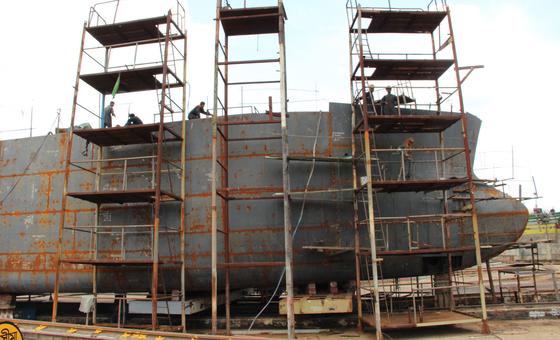The entire shipping industry must invest urgently in sustainability if it is to withstand future shocks and help prevent another global cost-of-living crisis linked to supply chain disruption, UN trade and development experts UNCTAD said on Tuesday.
“Ships carry over 80 per cent of the goods traded globally, with the percentage even higher for most developing countries; hence the urgent need to boost resilience to shocks that disrupt supply chains, fuel inflation and affect the poorest the most,” the UN agency said in a new report on maritime transport.
Between 2020 and 2021, UNCTAD also noted that carbon emissions from the world’s maritime fleet increased by almost five per cent. At the same time, data indicated that the average age of the ships in service has increased, to almost 22 years.
Straitened times
Replacing these ageing vessels is key to ensuring the maritime industry’s transition to a low-carbon future, said UNCTAD Secretary-General Rebeca Grynspan, who also called for “predictable global rules” to support the industry, ports and shipowners.
“In terms of green and climate regulation we must move from the many and messy rules we have now, to one system that is good for all,” she told journalists in Geneva. “This is critical given the highly uncertain environment, with conflict risks…and unknown price of carbon in the future.”
Inflationary setting
UNCTAD warned that “surging borrowing costs” will likely hamper the replacement of old ships, while also calling for increased support for developing countries in making the switch to low or zero-carbon fuels.
“Ports, shipping fleets and hinterland connections need to be better prepared for future global crises, climate change and the transition to low-carbon energy,” UNCTAD said.
Investing in shipping logistics would prevent the kind of inflationary pressures that continue to hold back the industry, the UN agency continued.
In 2021, at the height of the COVID-19 crisis, a shortage of containers combined with surging demand for consumer goods and e-commerce “pushed container spot freight rates to five times their pre-pandemic levels”, UNCTAD said.

A ship passes through a section of the Panama Canal, one of the busiest trading routes in the world.
Price spike
Prices for containers reached record highs in early 2022 which translated into sharply higher consumer prices, the UNCTAD report continued. Although these rates have dropped since the middle of this year, “they remain high for oil and natural gas tanker cargo due to the ongoing energy crisis” linked to Russia’s invasion of Ukraine.
According to UNCTAD’s Review of Maritime Transport 2022, freight costs for dry goods such as grain have also increased this year because of the war in Ukraine, COVID-19 and supply chain disruptions. The result is likely to be a 1.2 per cent increase in consumer food prices, which will hit low and middle-income countries worst.
“If there is one thing we have learned from the crisis of the last two years it is that ports and shipping greatly matter for a well-functioning global economy,” said Shamika Sirimanne, Director of UNCTAD’s technology and logistics division. “Higher freight rates have led to surging consumer prices, especially for the most vulnerable. Interrupted supply chains led to lay-offs and food insecurity.”

